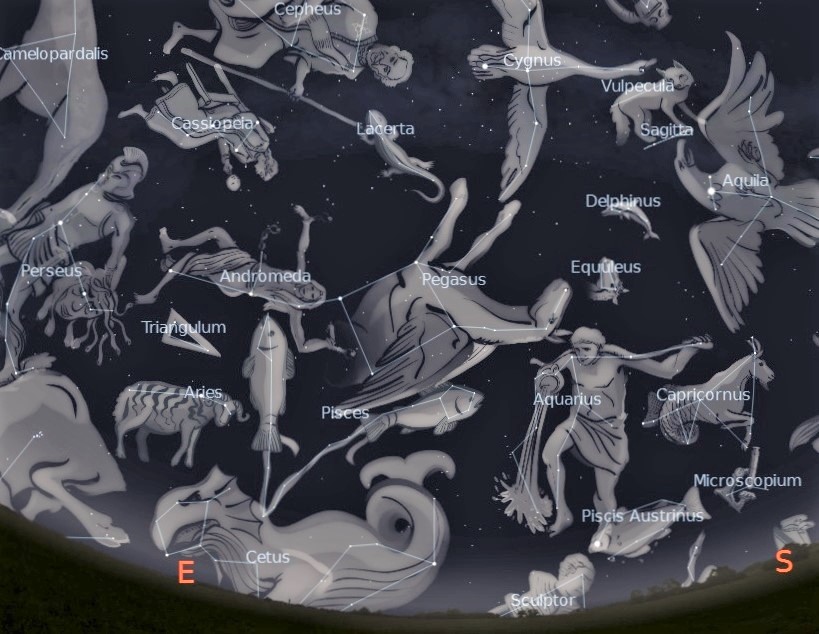This Week’s Sky at a Glance, 2021 September 18 –25
~by Curt Nason
Autumn arrives this week, and dedicated stargazers are happy to have the longer observing time afforded by earlier sunsets. The summer constellations appear reluctant to move on, however; emerging from twilight in nearly the same place each night because the earlier darkness masks that they rise four minutes sooner each day. But move on they do, and by mid-evening the two groups of autumn constellations lord over us.
Perseus sits below W-shaped Cassiopeia in the northeast these evenings. Cepheus is a house-shaped constellation north of Cassiopeia, and Andromeda lies with her feet below Cassiopeia and her head sharing a star with Pegasus. The asterism called the Great Square of Pegasus rises as a large diamond, a harbinger of the baseball post season. These constellations relate to a classic tale in Greek mythology, as does Cetus, playing the role of a ferocious sea monster. Cetus is actually a whale, and this segues to the second group – the water constellations.
Saturn and Jupiter are in or near ark-shaped Capricornus the sea goat. Above and left is the source of all this water; Aquarius, the water bearing servant of the Olympian gods. Below him is the southern fish, Piscis Austrinus with the bright star Fomalhaut, and further east we have Pisces the fishes. Cetus swims below them, and well above Capricornus we see Delphinus the dolphin trying to leap back into summer.
This Week in the Solar System
Saturday’s sunrise in Moncton is at 7:01 am and sunset will occur at 7:24 pm, giving 12 hours, 23 minutes of daylight (7:06 am and 7:28 pm in Saint John). Next Saturday the Sun will rise at 7:10 am and set at 7:10 pm, giving 12 hours of daylight (7:15 am and 7:15 pm in Saint John). The Sun is above the equator on Wednesday at 4:21 pm, beginning our autumn season. Note that we have 12 hours of daylight three days after the equinox. If we had no atmosphere and if sunrise and sunset times were based on the middle of the Sun, then equal day and night would occur on the equinox. However, sunrise is when the top of the Sun appears and sunset is when the top disappears. Also, atmospheric refraction makes the Sun appear to be sitting on the horizon, rising and setting, when it is actually just below it. This extra time means we get equal day and night a few days before the first of spring and a few days after the first of autumn.
The Harvest Moon occurs on Monday evening, rising just 20-30 minutes later each evening all week rather than the average time of 50 minutes. Saturn and Jupiter are at their best for observing in mid-to-late evening. Jupiter’s Red Spot can be seen with a telescope around 8:30 pm Wednesday and 10 pm on Friday. Venus sets before 9 pm this week, and Mercury is a challenge to see with binoculars, setting 30 minutes after sunset.
Questions? Contact Curt Nason.

